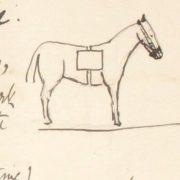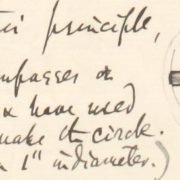1 – Letter to Frederick Smith from Francis Galton, 27 Nov 1897
The copyright of this material belongs to descendants of the creator. Images are permitted for reuse under a Creative Commons, Attribution, Non-commercial license.
Click here for full transcript of letter
[FS/3/3/2/1]
[[1]]
42 Rutland Gate Rd
Nov 27/97
Dear Captain Smith,
Since writing & talking with you about horses, I have not being [sic] idle but have been puzzling in various directions, and now want to consult you once again. Let me first say that I have had a good work at the Records of American Trotting horses, and finished a memoir thereon, not yet printed. It seems that there exists a very valuable collection of facts there, that could be used for hereditary inquiry, but which is at present practically inaccessible,
[[2]]
though with a little management it might to all appearance be easily obtained. I am in full correspondence about this, & only mention it now to shew that I am hopefully busy.
What I want now to ask you about, relates to the former question of horse – measurement, and to the following idea.
I suppose there to be little difficulty in gradually initialising a custom of having a “common” photograph taken of each valuable horse in the way to be described[.] I mean quite independently of the artistic and costly photos now usual.
[[3]]
The “common” photo is intended to carry on its face the necessary data for making measurements in the photograph itself, and these seem to be very sensible.
- for the body, a stiff leather & dark plate, with a white (or blue, which is white photographically & less staring?) rectangle in paper of say 20 inches x 10 inches attached to it, which might be graduated & bear a recognised standard mark[.]
- for the head, a graduated headstall (lengthways.
[[4]]
It seems to me from looking at horses in the street in harness, & those with waterproof rugs over their backs, that a plate of the sort I mean would practically coincide with a vertical plane tangential to the horse’s side. *postscript [struck-through text illeg] there would be no [illeg] difficulty in getting correct measures however much (within reasonable limits) the vertical position of the horse was oblique to the line of slight[.] For, by prolonging in pencil in the photograph of the top and bottom lines, seen in perspective, a vertical scale suitable to that perspective is obtained, and the horizontal scale can be easily deduced. Thus all the [vertic] distances in a vertical plane tangential to the side of the horse can be measured from the photo.
[[5]]
The graduated head stall would give a similar means of measuring the head; whatever its obliqueness to this line of sight might be[.]
3/ In measuring the body, the points in it might be spotted, with a small stiff brush dipped in chalk and water, before photographing. Precautions being of course insisted on, that these should be done by a skilled & trustworthy person[.]
It seems to my very enthusiastic
[[6]]
mind, that the interest & utility of providing means for future accurate measurement of every valuable horse, would lead in time (if the movement were first stabled in respect to the winners at prize shows) to its pretty general adoption[.] The points to be dotted with chalk and water are those we talked about, subject of course to re-consideration.
How does all this strike you? I should truly be obliged to free criticism, not wishing to make any move in a subject on which I have so little
[[7]]
practical knowledge, without approval from those who have.
Very faithfully yours with kind remembrances to Mrs Smith
Francis Galton
To avoid prolixity I have perhaps not entered fully enough into the ways of getting a scale from the graduations in the plate. The plate may slope vertically as well as in the way described but a divergence of even 8⁰ makes only percent error!
The data for finding all out, are the measured lengths in the photograph of AB, AC, and CD (page 4).
[[8]]
The scale for any measurement in the tan vertical tangential plane to the horses side can be deduced from these data, either by graphic methods such as architectural draughtsmen use, or perhaps more simply by the help of tables for the purpose. I worked out many of these during another & different attempt with horse – photographers, but have not regularly thought these out those that are suitable for the present purpose. There seems no difficulty in doing so.










